Enjoy our triplist below! For our tour
description, itinerary, past triplists, dates, fees, and more,
please visit our TOUR PAGE.
Click on the link at right to see this
triplist in printable PDF format with media only on
page 1.
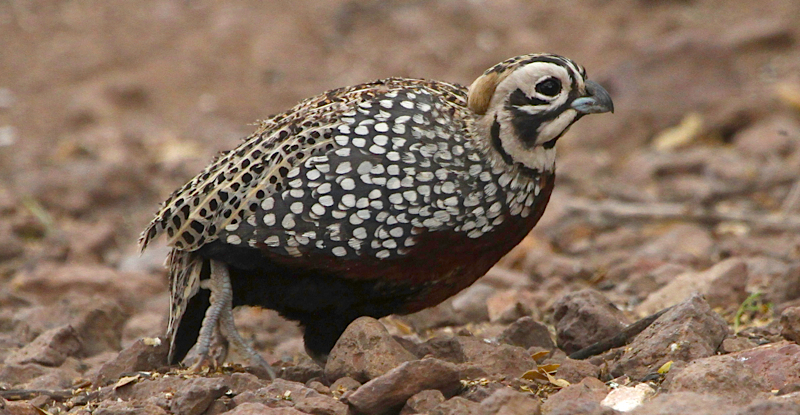
Always a
much-wanted bird in the southwest, a harlequin male
Montezuma Quail is surprisingly cryptic despite its boldly
patterned plumage. (Photo by guide Chris Benesh)
This year's Big Bend and Texas Hill Country trip was
memorable for several reasons, and was characterized by mostly
great weather, great wildlife sightings, and great company!
We started out at the San Antonio airport where nearly all of
us headed out on schedule to bird our way to Del Rio. George
caught up with us there, and we enjoyed some nice views of
things, though our sought-after vireos proved a bit elusive.
We did enjoy a lovely pair of Zone-tailed Hawks, though. The
next morning, we birded a couple of sites near the Rio Grande
in Del Rio and added a number of "South Texas" specialties to
the list, with such goodies as Olive Sparrow, Great Kiskadee,
Couch's Kingbird, and even White-collared Seedeater. Then it
was time to head west to Big Bend National Park.
Conditions were rather dry once we got all of the way out to
Big Bend. While that made it tough for a few things, it did
make the oasis birding a little more interesting, and
thankfully, the oaks had leafed out on the hike to Boot
Spring, so the Colima Warblers were happy and singing. It was
beautiful the day we made the hike up to the springs, and
there were a few other birds to distract us along the way.
Once we had finished at Big Bend, we headed north to the
Davis Mountains for an overnight. The highlight of this
venture was certainly the lovely pair of Montezuma Quail that
greeted us soon after we arrived. A number of other
interesting species were coming in to feed and keep us
entertained.
Then it was off again the next morning, this time heading
east to the Hill Country and Utopia. We made a major stop
along the way at Lake Balmorhea, which was a treasure trove of
aquatic birds. All of the Clark's Grebes (some with chicks),
the flocks of Wilson's Phalaropes and Franklin's Gulls alone
were worth the price of admission. Then it was on to Utopia.
The Hill Country was greener than where we'd been, and we had
some good luck with most things. Golden-cheeked Warbler was a
real highlight, and we had a couple of unexpected warbler
bonuses in the way of Tropical Parula and a Rufous-capped
Warbler. More color was provided by Painted and Indigo
buntings. And there can't be any better way to wrap up a tour
than an evening visit to the Frio Bat Cave. The sight of
millions of bats streaming out of the mouth of the cave is an
experience that will stay with you for a lifetime.
So I hope everyone is already making their plans for the
reunion tour. You were a great bunch of folks to travel with
and it would certainly be my pleasure to travel with you
again. Maybe southeast Arizona in 2013? Until we get together
again, all the best and may you have plenty of wonderful
birding experiences along the way.
--Chris
For more information about this tour, including future
departures, visit our website at www.fieldguides.com.
And to see this same triplist online, go to http://www.fieldguides.com/triplists/big12LIST.pdf
and you will find the list in its entirety.
KEYS FOR THIS LIST
One of the following keys may be shown in brackets for
individual species as appropriate: * = heard only, I =
introduced, E = endemic, N = nesting, a = austral migrant, b =
boreal migrant
Anatidae (Ducks, Geese, and Waterfowl)
BLACK-BELLIED WHISTLING-DUCK (Dendrocygna autumnalis)
FULVOUS
WHISTLING-DUCK (Dendrocygna
bicolor)
WOOD DUCK (Aix sponsa)
GADWALL (Anas strepera)
AMERICAN WIGEON
(Anas americana)
MALLARD (MEXICAN)
(Anas platyrhynchos diazi)
BLUE-WINGED TEAL
(Anas discors)
CINNAMON TEAL
(Anas cyanoptera)
NORTHERN SHOVELER
(Anas clypeata)
REDHEAD (Aythya americana)
LESSER SCAUP
(Aythya affinis)
RUDDY DUCK
(Oxyura jamaicensis)
Odontophoridae (New World Quail)
SCALED QUAIL (Callipepla squamata)
NORTHERN BOBWHITE
(Colinus virginianus) [*]
MONTEZUMA QUAIL
(Cyrtonyx montezumae)
Phasianidae (Pheasants, Grouse, and
Allies)
WILD TURKEY (Meleagris gallopavo)
Podicipedidae (Grebes)
PIED-BILLED GREBE (Podilymbus podiceps)
EARED GREBE
(Podiceps nigricollis)
WESTERN GREBE
(Aechmophorus occidentalis)
CLARK'S GREBE
(Aechmophorus clarkii)
Phalacrocoracidae (Cormorants and Shags)
NEOTROPIC CORMORANT (Phalacrocorax brasilianus)
Ardeidae (Herons, Egrets, and Bitterns)
GREAT BLUE HERON (Ardea herodias)
GREAT EGRET
(Ardea alba)
CATTLE EGRET
(Bubulcus ibis)
BLACK-CROWNED
NIGHT-HERON (Nycticorax
nycticorax)
YELLOW-CROWNED
NIGHT-HERON (Nyctanassa
violacea)
Threskiornithidae (Ibises and Spoonbills)
WHITE-FACED IBIS (Plegadis chihi)
Cathartidae (New World Vultures)
BLACK VULTURE (Coragyps atratus)
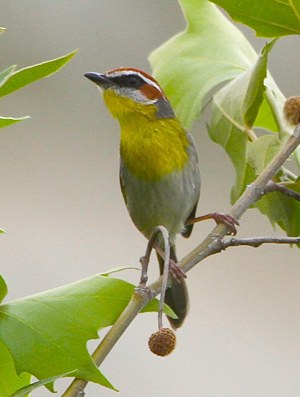
This close to the
southern border of the US, there's always the hope of a
Mexican vagrant. Hopes were fulfilled when this beautiful
Rufous-capped Warbler was found at Park Chalk Bluff just
before the tour began! (Photo by guide Chris Benesh)
TURKEY VULTURE (Cathartes aura)
Pandionidae (Osprey)
OSPREY (Pandion
haliaetus)
Accipitridae (Hawks, Eagles, and Kites)
MISSISSIPPI KITE (Ictinia mississippiensis)
NORTHERN HARRIER
(Circus cyaneus)
COOPER'S HAWK
(Accipiter cooperii)
COMMON BLACK-HAWK
(Buteogallus anthracinus)
GRAY HAWK (Buteo nitidus)
SWAINSON'S HAWK
(Buteo swainsoni)
ZONE-TAILED HAWK
(Buteo albonotatus)
RED-TAILED HAWK
(Buteo jamaicensis)
Falconidae (Falcons and Caracaras)
CRESTED CARACARA (Caracara cheriway)
AMERICAN KESTREL
(Falco sparverius)
PEREGRINE FALCON
(Falco peregrinus)
Rallidae (Rails, Gallinules, and Coots)
COMMON GALLINULE (Gallinula galeata)
AMERICAN COOT
(Fulica americana)
Charadriidae (Plovers and Lapwings)
KILLDEER (Charadrius
vociferus)
Recurvirostridae (Stilts and Avocets)
BLACK-NECKED STILT (Himantopus mexicanus)
AMERICAN AVOCET
(Recurvirostra americana)
Scolopacidae (Sandpipers and Allies)
SPOTTED SANDPIPER (Actitis macularius)
WESTERN SANDPIPER
(Calidris mauri)
LEAST SANDPIPER
(Calidris minutilla)
BAIRD'S SANDPIPER
(Calidris bairdii)
LONG-BILLED
DOWITCHER (Limnodromus
scolopaceus)
WILSON'S PHALAROPE
(Phalaropus tricolor)
Laridae (Gulls, Terns, and Skimmers)
FRANKLIN'S GULL (Leucophaeus pipixcan)
RING-BILLED GULL
(Larus delawarensis)
Columbidae (Pigeons and Doves)
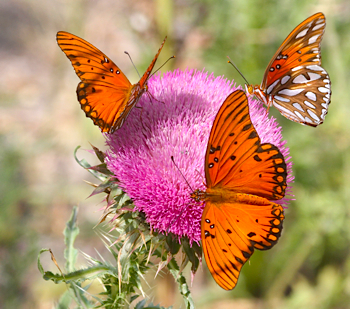
Adding a splash
of color to the dry landscape, a trio of brilliant Gulf
Fritillaries share a thistle flower. (Photo by guide Chris
Benesh)
ROCK PIGEON (Columba livia) [I]
EURASIAN
COLLARED-DOVE (Streptopelia
decaocto) [I]
WHITE-WINGED DOVE
(Zenaida asiatica)
MOURNING DOVE
(Zenaida macroura)
INCA DOVE (Columbina inca)
COMMON GROUND-DOVE
(Columbina passerina)
WHITE-TIPPED DOVE
(WHITE-TIPPED) (Leptotila
verreauxi angelica) [*]
Cuculidae (Cuckoos)
GREATER ROADRUNNER (Geococcyx californianus)
Strigidae (Owls)
EASTERN SCREECH-OWL (Megascops asio)
ELF OWL (Micrathene whitneyi) [*]
Caprimulgidae (Nightjars and Allies)
COMMON NIGHTHAWK (Chordeiles minor)
COMMON POORWILL
(Phalaenoptilus nuttallii)
CHUCK-WILL'S-WIDOW
(Caprimulgus carolinensis)
Apodidae (Swifts)
CHIMNEY SWIFT (Chaetura pelagica)
WHITE-THROATED
SWIFT (Aeronautes saxatalis)
Trochilidae (Hummingbirds)
BLUE-THROATED HUMMINGBIRD (Lampornis clemenciae)
LUCIFER
HUMMINGBIRD (Calothorax
lucifer)
RUBY-THROATED
HUMMINGBIRD (Archilochus
colubris)
BLACK-CHINNED
HUMMINGBIRD (Archilochus
alexandri)
BROAD-TAILED
HUMMINGBIRD (Selasphorus
platycercus)
Alcedinidae (Kingfishers)
RINGED KINGFISHER (Megaceryle torquata) [*]
BELTED KINGFISHER
(Megaceryle alcyon)
GREEN KINGFISHER
(Chloroceryle americana)
Picidae (Woodpeckers)
ACORN WOODPECKER (Melanerpes formicivorus)
GOLDEN-FRONTED
WOODPECKER (Melanerpes
aurifrons)
LADDER-BACKED
WOODPECKER (Picoides scalaris)
Tyrannidae (Tyrant Flycatchers)
WESTERN WOOD-PEWEE (Contopus sordidulus)
EASTERN WOOD-PEWEE
(Contopus virens)
ACADIAN FLYCATCHER
(Empidonax virescens)
BLACK PHOEBE
(Sayornis nigricans)
EASTERN PHOEBE
(Sayornis phoebe)
SAY'S PHOEBE
(Sayornis saya)
VERMILION
FLYCATCHER (Pyrocephalus
rubinus)
ASH-THROATED
FLYCATCHER (Myiarchus
cinerascens)
GREAT CRESTED
FLYCATCHER (Myiarchus
crinitus) [*]
BROWN-CRESTED
FLYCATCHER (Myiarchus
tyrannulus)
GREAT KISKADEE
(Pitangus sulphuratus)
COUCH'S KINGBIRD
(Tyrannus couchii)
CASSIN'S KINGBIRD
(Tyrannus vociferans)
WESTERN KINGBIRD
(Tyrannus verticalis)
SCISSOR-TAILED
FLYCATCHER (Tyrannus
forficatus)
Laniidae (Shrikes)
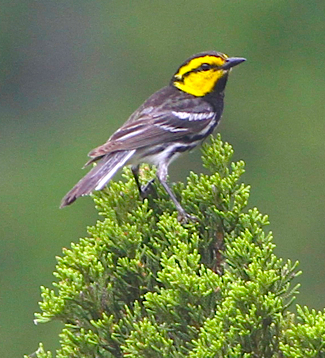
A Texas breeding
endemic, the rare Golden-cheeked Warbler breeds only in
mature oak-juniper woodlands on the Edwards Plateau. This
was the overall winner as the top bird of the trip. (Photo
by guide Chris Benesh)
LOGGERHEAD SHRIKE (Lanius ludovicianus)
Vireonidae (Vireos)
WHITE-EYED VIREO (Vireo griseus)
BELL'S VIREO
(Vireo bellii)
BLACK-CAPPED VIREO
(Vireo atricapilla)
YELLOW-THROATED
VIREO (Vireo flavifrons)
HUTTON'S VIREO
(Vireo huttoni)
RED-EYED VIREO
(Vireo olivaceus)
Corvidae (Crows, Jays, and Magpies)
WESTERN SCRUB-JAY (Aphelocoma californica)
MEXICAN JAY
(Aphelocoma wollweberi)
COMMON RAVEN
(Corvus corax)
Hirundinidae (Swallows)
NORTHERN ROUGH-WINGED SWALLOW (Stelgidopteryx serripennis)
PURPLE MARTIN
(Progne subis)
VIOLET-GREEN
SWALLOW (Tachycineta
thalassina)
BANK SWALLOW
(Riparia riparia)
BARN SWALLOW
(Hirundo rustica)
CLIFF SWALLOW
(Petrochelidon pyrrhonota)
CAVE SWALLOW
(Petrochelidon fulva)
Paridae (Chickadees and Tits)
CAROLINA CHICKADEE (Poecile carolinensis)
BLACK-CRESTED
TITMOUSE (Baeolophus
atricristatus)
Remizidae (Penduline-Tits)
VERDIN (Auriparus
flaviceps)
Aegithalidae (Long-tailed Tits)
BUSHTIT (Psaltriparus
minimus)
Troglodytidae (Wrens)
CACTUS WREN (Campylorhynchus brunneicapillus)
ROCK WREN (Salpinctes obsoletus)
CANYON WREN
(Catherpes mexicanus)
CAROLINA WREN
(Thryothorus ludovicianus)
BEWICK'S WREN
(Thryomanes bewickii)
HOUSE WREN
(Troglodytes aedon)
Polioptilidae (Gnatcatchers)
BLUE-GRAY GNATCATCHER (Polioptila caerulea)
BLACK-TAILED
GNATCATCHER (Polioptila
melanura)
Regulidae (Kinglets)
RUBY-CROWNED KINGLET (Regulus calendula)
Turdidae (Thrushes and Allies)
EASTERN BLUEBIRD (Sialia sialis)
TOWNSEND'S
SOLITAIRE (Myadestes
townsendi)
SWAINSON'S THRUSH
(OLIVE-BACKED) (Catharus
ustulatus swainsoni)
AMERICAN ROBIN
(Turdus migratorius)
Mimidae (Mockingbirds and Thrashers)
NORTHERN MOCKINGBIRD (Mimus polyglottos)
LONG-BILLED
THRASHER (Toxostoma
longirostre)
CURVE-BILLED
THRASHER (Toxostoma
curvirostre)
CRISSAL THRASHER
(Toxostoma crissale)
Sturnidae (Starlings)
EUROPEAN STARLING (Sturnus vulgaris) [I]
Motacillidae (Wagtails and Pipits)
AMERICAN PIPIT (Anthus rubescens)
Bombycillidae (Waxwings)
CEDAR WAXWING (Bombycilla cedrorum)
Ptilogonatidae (Silky-flycatchers)
PHAINOPEPLA (Phainopepla nitens)
Parulidae (New World Warblers)
LOUISIANA WATERTHRUSH (Parkesia motacilla)
BLACK-AND-WHITE
WARBLER (Mniotilta varia)
ORANGE-CROWNED
WARBLER (Oreothlypis celata)
COLIMA WARBLER
(Oreothlypis crissalis)
NASHVILLE WARBLER
(Oreothlypis ruficapilla)
MACGILLIVRAY'S
WARBLER (Geothlypis tolmiei)
COMMON
YELLOWTHROAT (Geothlypis
trichas)
HOODED WARBLER
(Setophaga citrina) [*]
TROPICAL PARULA
(NORTHEAST MEXICO) (Setophaga
pitiayumi nigrilora)
YELLOW WARBLER
(Setophaga petechia) [*]
YELLOW-RUMPED
WARBLER (AUDUBON'S) (Setophaga
coronata auduboni)
YELLOW-THROATED
WARBLER (Setophaga dominica)
TOWNSEND'S WARBLER
(Setophaga townsendi)
HERMIT WARBLER
(Setophaga occidentalis)
GOLDEN-CHEEKED
WARBLER (Setophaga
chrysoparia)
RUFOUS-CAPPED
WARBLER (Basileuterus
rufifrons)
WILSON'S WARBLER
(Cardellina pusilla)
PAINTED REDSTART
(Myioborus pictus) [*]
YELLOW-BREASTED
CHAT (Icteria virens)
Emberizidae (Buntings, Sparrows and
Allies)
WHITE-COLLARED SEEDEATER
(WHITE-COLLARED) (Sporophila
torqueola sharpei)
OLIVE SPARROW
(Arremonops rufivirgatus)
GREEN-TAILED
TOWHEE (Pipilo chlorurus)
SPOTTED TOWHEE
(Pipilo maculatus)
RUFOUS-CROWNED
SPARROW (Aimophila ruficeps)
CANYON TOWHEE
(Melozone fusca)
CASSIN'S SPARROW
(Peucaea cassinii)
CHIPPING SPARROW
(Spizella passerina)
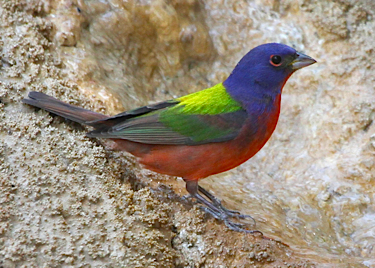
Is this the
gaudiest bird in North America or what? The male Painted
Bunting never fails to brighten his surroundings! (Photo
by guide Chris Benesh)
CLAY-COLORED SPARROW (Spizella pallida)
BREWER'S SPARROW
(Spizella breweri)
FIELD SPARROW
(Spizella pusilla)
BLACK-CHINNED
SPARROW (Spizella atrogularis)
VESPER SPARROW
(Pooecetes gramineus)
LARK SPARROW
(Chondestes grammacus)
BLACK-THROATED
SPARROW (Amphispiza bilineata)
LARK BUNTING
(Calamospiza melanocorys)
SAVANNAH SPARROW
(Passerculus sandwichensis)
GRASSHOPPER
SPARROW (Ammodramus
savannarum)
LINCOLN'S SPARROW
(Melospiza lincolnii)
WHITE-CROWNED
SPARROW (Zonotrichia
leucophrys)
Cardinalidae (Cardinals and Allies)
HEPATIC TANAGER (Piranga flava)
SUMMER TANAGER
(Piranga rubra)
WESTERN TANAGER
(Piranga ludoviciana)
NORTHERN CARDINAL
(Cardinalis cardinalis)
PYRRHULOXIA
(Cardinalis sinuatus)
BLACK-HEADED
GROSBEAK (Pheucticus
melanocephalus)
BLUE GROSBEAK
(Passerina caerulea)
LAZULI BUNTING
(Passerina amoena)
INDIGO BUNTING
(Passerina cyanea)
VARIED BUNTING
(Passerina versicolor)
PAINTED BUNTING
(Passerina ciris)
DICKCISSEL
(Spiza americana)
Icteridae (Troupials and Allies)
RED-WINGED BLACKBIRD (Agelaius phoeniceus)
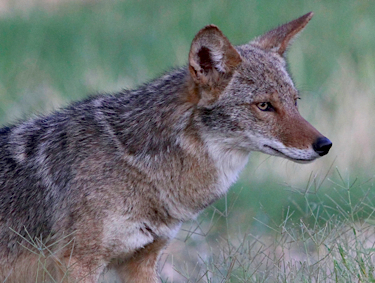
Contrary to
popular belief, wily Coyotes are rarely seen in pursuit of
roadrunners. (Photo by guide Chris Benesh)
EASTERN MEADOWLARK (Sturnella magna)
YELLOW-HEADED
BLACKBIRD (Xanthocephalus
xanthocephalus)
BREWER'S BLACKBIRD
(Euphagus cyanocephalus)
COMMON GRACKLE
(Quiscalus quiscula)
GREAT-TAILED
GRACKLE (Quiscalus mexicanus)
BRONZED COWBIRD
(Molothrus aeneus)
BROWN-HEADED
COWBIRD (Molothrus ater)
ORCHARD ORIOLE
(Icterus spurius)
HOODED ORIOLE
(Icterus cucullatus)
BULLOCK'S ORIOLE
(Icterus bullockii)
SCOTT'S ORIOLE
(Icterus parisorum)
Fringillidae (Siskins, Crossbills, and
Allies)
HOUSE FINCH (Carpodacus mexicanus)
PINE SISKIN
(Spinus pinus)
LESSER GOLDFINCH
(Spinus psaltria)
AMERICAN GOLDFINCH
(Spinus tristis)
Passeridae (Old World Sparrows)
HOUSE SPARROW (Passer domesticus) [I]
WESTERN
PIPISTRELLE (Pipistrellus
hesperus)
BRAZILIAN
FREE-TAILED BAT (Tadarida
brasiliensis)
NINE-BANDED
ARMADILLO (Dasypus
novemcinctus)
EASTERN COTTONTAIL
(Sylvilagus floridanus)
DESERT COTTONTAIL
(Sylvilagus audubonii)
BLACK-TAILED
JACKRABBIT (Lepus
californicus)
TEXAS ANTELOPE
SQUIRREL (Ammospermophilus
interpres)
ROCK SQUIRREL
(Spermophilus variegatus)
FOX SQUIRREL
(Sciurus niger)
NORTH AMERICAN
PORCUPINE (Erethizon dorsatum)
GRAY FOX (Urocyon cinereoargenteus)
COYOTE (Canis latrans)
BLACK BEAR
(Ursus americanus)
COLLARED PECCARY
(Tayassu tajacu)
SPOTTED DEER
(Axis axis) [I]
MULE DEER (Odocoileus hemionus)
WHITE-TAILED DEER
(Odocoileus virginianus)
A few other memorable critters include the pink Coachwhip
snake that came in to drink at Sam Nail Ranch, and a number of
Texas Earless Lizards and some Texas Spotted Whiptails.
Also memorable was the glow in the dark scorpion we saw under
UV light near the lodge in the Chisos Mountains.
Totals for the tour: 205 bird taxa and 17 mammal taxa






